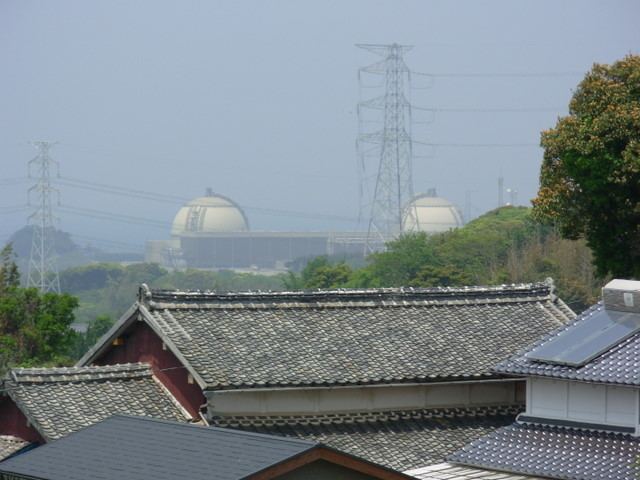Country Japan Reactor type PWR Phone +81 955-52-6821 Construction began 15 September 1971 | Status Out of service Owner Kyushu Electric Power | |
 | ||
Commission date October 15, 1975 (1975-10-15) Operator(s) Kyushu Electric Power Company Similar Sendai Nuclear Power Pl, Mihama Nuclear Power Pl, Takahama Nuclear Power Pl, Tomari Nuclear Power Pl, Ikata Nuclear Power Pl | ||
Strongest earthquake since march 2011 rocks japan near sendai genkai nuclear power plants
The Genkai Nuclear Power Plant (玄海原子力発電所, Genkai genshiryoku hatsudensho, Genkai NPP) is a nuclear power plant located in the town of Genkai in the Higashimatsuura District in the Saga Prefecture. It is owned and operated by the Kyūshū Electric Power Company.
Contents
- Strongest earthquake since march 2011 rocks japan near sendai genkai nuclear power plants
- Earthquakes
- Events
- Reactors on site
- 2011 restart controversy and reclosure
- Units 3 and 4 restart
- References
The reactors were all built by Mitsubishi Heavy Industries and are of the 2 and 4-loop M type pressurized water reactor. Unit 3 has been selected as a special Plutonium fuel test case. The plant is on a site with a total of 0.87 square kilometers.
Earthquakes
Saga does not lie on a fault line and receives the fewest earthquakes in Japan. The 2005 Fukuoka earthquake was felt at the plant, but there was no equipment damage.
Events
Reactors on site
All reactors at the Genkai plant use low enriched (3-4%) Uranium dioxide fuel.
Genkai 1 belongs to the first generation of PWR built by Mitsubishi, based on imported technology.
Genkai 2 is the first reactor of the second generation of Mitsubishi's PWR, fully using its own technology.
Genkai 3 and 4 represent the third generation of Mitsubishi's PWR, with further improvements.
2011 restart, controversy and reclosure
In early 2011, Units 2 and 3 were suspended for routine maintenance. Following the Tohoku earthquake, Kyushu Electric voluntarily sought reapproval with the town of Genkai and Saga prefecture to make sure that there would be no objection to turning the reactors back on. Negotiations extended several months past the normal restart time. Because Units 2 and 3 were not restarted for the summer, Kyushu was expected to have an electricity shortage and only be able to meet 85% of normal summer needs.
After the mayor of Genkai extended his approval, the larger consensus of Saga prefecture was sought. A meeting was organized to inform the people in the district and to get permission to restart the reactors. The meeting was broadcast live on TV and the internet, and viewers were invited to submit their opinions by e-mail or fax. Later, the Japanese Communist Party paper Akahata learned that the board of the Kyushu Electric Power Company had requested employees of the plant to send emails to this meeting encouraging the restart. Later it was admitted that not only employees of the utility but the workers of 4 affiliated firms too, more than 1,500 people in total, received such requests.
At the same time as this crisis broke, Prime Minister Naoto Kan unexpectedly requested more stress tests of the reactor. This seemed to imply, despite the earlier assurances of the national government, that the routine maintenance and additional post-earthquake tests had not been sufficient to clear the reactors for restart, and that the mayor of Genkai had therefore approved the restart without complete information about the reactors' safety. As a result, the mayor rescinded his approval. The governor of Saga, who had not yet given his approval, also expressed surprise. Chief Cabinet Secretary Yukio Edano flew to Saga prefecture immediately to apologize to the governor in person. On July 9, Kan also apologized.
On July 12, actor Taro Yamamoto, a Tokyo resident who had flown into Saga to protest the potential restart, broke into the offices of Saga prefecture trying to force the governor to come out. He was unsuccessful but proclaimed that he was glad he had come to protest.
On 2 November 2011 the No. 4 reactor, the newest model, was restarted. The reactor was the first in Japan to resume operations after the March accident at Fukushima Daiichi nuclear plant. In December the reactor was stopped again for a regular inspection.
On 9 December 2011 a leak was discovered in the cooling system of reactor No. 3. An alarm was triggered when the temperature rose to over 80C at the base of one of the pumps, but this alarm did not indicate the leakage of 1.8 cubic meters of radioactive water, because the water did not go outside the purification system. After the leak was discovered Kyushu Electric failed to report the troubles in full to the local government. Only the failure of the pumps in the system for the No. 3 reactor were mentioned.
As of September 2012, Saga prefecture was aiming to have the Genkai reactors permanently retired after 40 years of operation, meaning that reactor 1 would close in 2015. A citizens' group sued to have the reactors shut down immediately, but the state argued that there is no process in Japanese law that could cause an industry's operations to cease through a civil, rather than criminal, action. As of April 2016, the plant remains shut down.
Units 3 and 4 restart
On 19 January 2017, units 3 and 4 received from NRA the confirmation of meeting the new regulatory standards.
